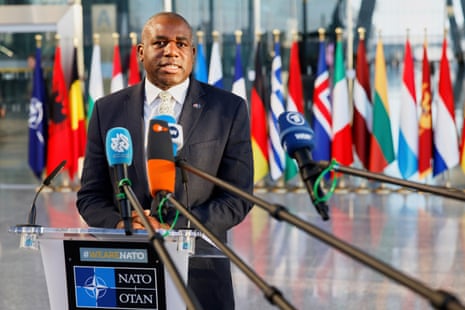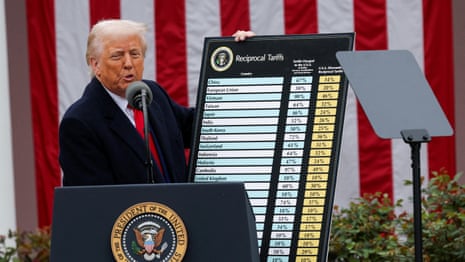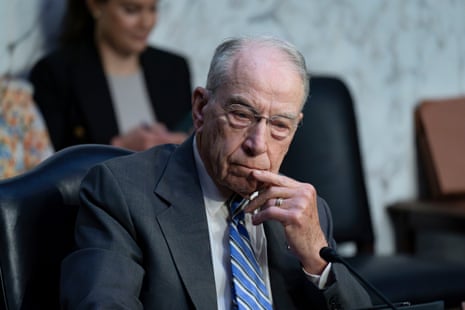Show key events only
Please turn on JavaScript to use this feature
Good morning, and welcome to our US politics blog.
Donald Trump fired Gen Tim Haugh, the director of the US National Security Agency (NSA) on Thursday, according to the top Democrats on the congressional intelligence committees.
The Washington Post reported yesterday evening that Haugh and his civilian deputy at the NSA, Wendy Noble, had been dismissed from their roles. Haugh also headed US Cyber Command, which coordinates the Pentagon’s cybersecurity operations.
Maggie Dougherty, who oversaw international organizations at the White House National Security Council (NSC), which advises the president on national security matters, was also let go, two sources told Reuters.
Earlier on Thursday, Trump said he had fired “some” White House national security council officials, a move that came a day after far-right activist and social media personality Laura Loomer raised concerns directly to him about staff loyalty.
Loomer, during her Oval Office conversation with the president, urged the president to purge staffers she deemed insufficiently loyal to his “Make America Great Again” agenda, according to several people familiar with the matter.

No reason was given for the removal of Gen Tim Haugh. Photograph: Leah Millis/Reuters
The move, which reportedly caught intelligence officials by surprise, has prompted an angry backlash from congressional Democrats.
Senator Mark Warner, vice-chair of the Senate intelligence committee, said in a statement: “General Haugh has served our country in uniform, with honor and distinction, for more than 30 years. At a time when the United States is facing unprecedented cyber threats … how does firing him make Americans any safer?”
Representative Jim Himes, the ranking member on the House intelligence committee, said he was “deeply disturbed by the decision”.
“I have known General Haugh to be an honest and forthright leader who followed the law and put national security first – I fear those are precisely the qualities that could lead to his firing in this administration,” Himes added. “The intelligence committee and the American people need an immediate explanation for this decision, which makes all of us less safe.”
The Trump team viewed Gen Haugh skeptically in part because he served as a top deputy at the cyber command under the Democratic president Joe Biden. We will have more on this story and other political news shortly.
Show key events only
Please turn on JavaScript to use this feature
China’s finance ministry has said it will impose additional tariffs of 34% on all US goods from 10 April as a countermeasure to sweeping tariffs imposed by Donald Trump.
As we reported in an earlier post, the Chinese ministry of commerce had called on the US to cancel the tariffs and promised unspecified countermeasures.
China has been hit particularly hard by the new tariffs, which take the total levy on Chinese imports to over 50%. The higher levies are due to come into effect from 9 April.
China, a key exporter to the US, of everything from clothing to kitchenware, has already announced a raft of retaliatory measures expected to raise prices for US consumers.
“There are no winners in trade wars and tariff wars,” China’s foreign ministry spokesperson Guo Jiakun said earlier this week. “It’s clear to everyone that more and more countries are opposing the unilateral bullying actions of the US”.
My colleagues have done a useful explainer breaking down what Trump’s tariffs are and how they’ve affected the economy since the announcement. Here is an extract from it:
What exactly are the new tariffs Trump is imposing?
Trump’s new tariffs are twofold. First, all imported goods will be subject to a 10% universal tariff starting 5 April. Then, on 9 April, certain countries will see higher tariff rates – what Trump has deemed “reciprocal tariffs” in retaliation for tariffs the countries have placed on American exports.
Keep in mind that tariffs are paid by American companies that are importing goods such as wine from Europe or microchips from Taiwan.
Some of the highest tariffs will be put on imports from Asian countries, including China, India, South Korea and Japan. EU exports will also have a 20% tariff.
Map of ‘reciprocal tariff’ rates announced by Donald Trump on 2 April
How did the White House calculate the tariffs?
The administration said that it looked at the trade deficit between the US and a specific country as a percentage, and then considered that to be a tariff. So, for example, the value of US goods that are exported to China are 67% of the value of the Chinese goods that are imported into the US.
The White House calls this definition a “tariff” placed on American goods, though a deficit and a tariff are not the same thing. It then halved the “tariff” and used that percentage to represent the new levy that the US would place on goods from that country.
Chart with x and y axis covered in red dots
Nato foreign ministers are meeting in Brussels today to talk about Russia’s war on Ukraine. Increased defence investment is a key item on the agenda. But some of European’s foreign ministers, including the UK’s David Lammy, have been asked about Trump’s sweeping tariffs on the way in.
Speaking to journalists, Lammy suggested Trump was taking US economic policy back almost a century by embracing protectionism. The British foreign minister explained:
The United Kingdom, like France, is a great maritime nation.
We are a nation that believes in open trade, and I regret the return to protectionism in the United States, something that we’ve not seen for nearly a century.
As you know, we are consulting with business and industry. At this time, we are engaged in discussions with the United States to strike an economic agreement and an economic deal.
And of course, we have been absolutely clear that all options are on the table as we ensure the national interests of the British people, who will be very concerned at this time about how this affects the bottom line for them and their economic welfare.
We will put their national interest first, and it’s in their national interests to be negotiating with the United States an economic agreement at this time, but keeping all options on the table.

David Lammy addresses the media during the meeting of Nato foreign ministers at the alliance’s headquarters in Brussels. Photograph: Geert Vanden Wijngaert/AP
You can keep up to date with all the developments in UK politics in Andrew Sparrow’s brilliant live blog.
Donald Trump said he thinks his tariff plan is going “very well” despite his announcement causing chaos in global markets.
Speaking to reporters last night, the US president said:
I think it’s going well. It was an operation – like when a patient gets operated on and it’s a big thing.
I said this would exactly be the way it is. We have 6 or 7 trillion dollars coming into our country and we have never seen anything like it.
The markets are going to boom, the stock (market) is going to boom, the country is going to boom and the rest of the world wants to see is there any way they can make a deal.
They have taken advantage of us for many many years.
Trump’s brash comments came despite the US financial market having suffered its biggest one-day loss since June 2020 on Thursday. American markets all closed lower – the Dow Jones dropped nearly 4% while the S&P 500 fell close to 5%.
As the Guardian’s media business correspondent Mark Sweney notes in this story, the economic fallout has continued today. Japan’s Nikkei index fell almost 3% on Friday, ending the week down 9%, while Tokyo’s Topix was down 4.5%. South Korea’s Kospi closed down 1.3%. In London, the FTSE 100 fell 41 points at the open on Friday morning.
Australia’s S&P/ASX 200 index fell 2.2% amid fears of a global recession after Trump’s announcement of the steepest trade barriers in more than 100 years.
Here is a video of Trump announcing the sweeping tariffs on Wednesday. They were regularly touted on the Republican’s presidential campaign trail but their scale have taken many commentators by surprise:

Trump announces sweeping new tariffs, upending decades of US trade policy – video

Lauren Gambino
Lauren Gambino is political correspondent for Guardian US
Senior senators introduced new bipartisan legislation on Thursday seeking to claw back some of Congress’s power over tariffs after Donald Trump unveiled sweeping new import taxes and rattled the global economy with sweeping new import taxes.
The Trade Review Act of 2025, co-sponsored by Senator Chuck Grassley, a top Republican lawmaker from Iowa, a state heavily reliant on farm exports, and Senator Maria Cantwell, a Democrat from Washington, whose state shares a border with Canada, would require the president to notify Congress of new tariffs, and provide a justification for the action and an analysis on the potential impact on US businesses and consumers.

Senior Republican lawmaker Chuck Grassley is introducing new legislation after Trump’s so-called “Liberation Day” tariff announcement. Photograph: J Scott Applewhite/AP
For the tariff to remain in effect, Congress would need to approve a joint resolution within 60 days. If Congress failed to give its consent within that timeframe, all new tariffs on imports would expire.
The legislation would also allow Congress to terminate tariffs at any time through a resolution of disapproval.
You can read the full story here:
Sweeping new tariffs announced by Donald Trump on Wednesday risked sparking a global trade war and have provoked widespread dismay and threats of countermeasures from countries around the world. Traders are warning about a US or even global recession, as stock markets continue to be hit by a brutal sell-off by investors.
Tariffs are border taxes charged on the import of goods from foreign countries. Importers pay them upon entry to the customs agency of the country or bloc that levies them.
Chinese goods, already subject to a 20% levy, received an additional 34% tariff, taking the total tariff to 54%. The additional levy takes effect on 9 April. China’s commerce ministry called the move “a typical act of unilateral bullying” and vowed to take “resolute countermeasures to safeguard its rights and interests”.
The reciprocal rates will come into effect from 12:01am on 9 April. They are in addition to a baseline 10% tariff which goes into effect from 12:01am on 5 April.
New Civil Liberties Alliance, a conservative legal group, on Thursday filed what it said was the first lawsuit seeking to block Trump’s tariffs on Chinese imports.
The lawsuit, filed in federal court in Florida, alleges that Trump lacked the legal authority to impose the sweeping 2 April tariffs as well as duties authorised on 1 February under the International Emergency Economic Powers Act.
In a statement, NCLA senior litigation counsel Andrew Morris said:
By invoking emergency power to impose an across-the-board tariff on imports from China that the statute does not authorize, President Trump has misused that power, usurped Congress’s right to control tariffs, and upset the Constitution’s separation of powers.
The lawsuit asks a judge to block implementation and enforcement of the tariffs and undo Trump’s changes to the US tariff schedule, according to Reuters.
My colleagues Hugo Lowell and Joseph Gedeon have more in this story on the surprise firing of Gen Tim Haugh, who had been the director of the National Security Agency for just over a year, having been nominated by former president Joe Biden in May 2023. His removal was revealed by Rep. Jim Himes of Connecticut, ranking member of the House intelligence committee, and Sen. Mark Warner of Virginia, vice-chair of the Senate intelligence committee.
The firings come as Trump’s national security adviser Mike Waltz continues to fight calls for his ouster after using the publicly available encrypted Signal app to discuss planning for the sensitive 15 March military operation targeting Houthi militants in Yemen.
Warner said on Thursday night, “It is astonishing, too, that President Trump would fire the nonpartisan, experienced leader of the National Security Agency while still failing to hold any member of his team accountable for leaking classified information on a commercial messaging app – even as he apparently takes staffing direction on national security from a discredited conspiracy theorist in the Oval Office.”
Haugh met last month with Elon Musk, whose “department of government efficiency”, or Doge, has roiled the federal government by slashing personnel and budgets at dozens of agencies. In a statement, the NSA said the meeting was intended to ensure both organizations were “aligned” with the new administration’s priorities.
Good morning, and welcome to our US politics blog.
Donald Trump fired Gen Tim Haugh, the director of the US National Security Agency (NSA) on Thursday, according to the top Democrats on the congressional intelligence committees.
The Washington Post reported yesterday evening that Haugh and his civilian deputy at the NSA, Wendy Noble, had been dismissed from their roles. Haugh also headed US Cyber Command, which coordinates the Pentagon’s cybersecurity operations.
Maggie Dougherty, who oversaw international organizations at the White House National Security Council (NSC), which advises the president on national security matters, was also let go, two sources told Reuters.
Earlier on Thursday, Trump said he had fired “some” White House national security council officials, a move that came a day after far-right activist and social media personality Laura Loomer raised concerns directly to him about staff loyalty.
Loomer, during her Oval Office conversation with the president, urged the president to purge staffers she deemed insufficiently loyal to his “Make America Great Again” agenda, according to several people familiar with the matter.

No reason was given for the removal of Gen Tim Haugh. Photograph: Leah Millis/Reuters
The move, which reportedly caught intelligence officials by surprise, has prompted an angry backlash from congressional Democrats.
Senator Mark Warner, vice-chair of the Senate intelligence committee, said in a statement: “General Haugh has served our country in uniform, with honor and distinction, for more than 30 years. At a time when the United States is facing unprecedented cyber threats … how does firing him make Americans any safer?”
Representative Jim Himes, the ranking member on the House intelligence committee, said he was “deeply disturbed by the decision”.
“I have known General Haugh to be an honest and forthright leader who followed the law and put national security first – I fear those are precisely the qualities that could lead to his firing in this administration,” Himes added. “The intelligence committee and the American people need an immediate explanation for this decision, which makes all of us less safe.”
The Trump team viewed Gen Haugh skeptically in part because he served as a top deputy at the cyber command under the Democratic president Joe Biden. We will have more on this story and other political news shortly.
